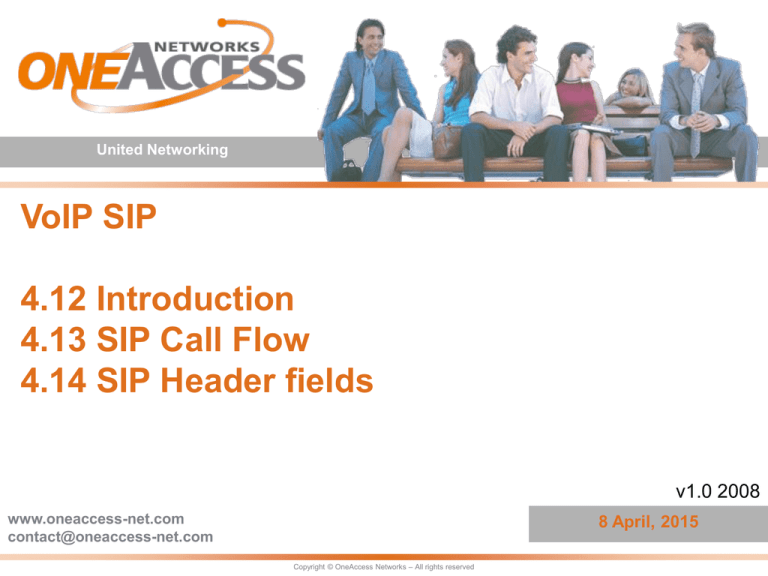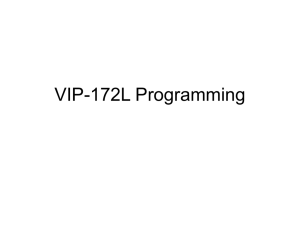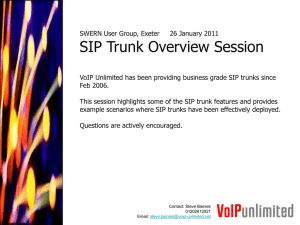
United Networking
VoIP SIP
4.12 Introduction
4.13 SIP Call Flow
4.14 SIP Header fields
v1.0 2008
www.oneaccess-net.com
contact@oneaccess-net.com
8 April, 2015
Copyright © OneAccess Networks – All rights reserved
VoIP
U nn iitte ed d N eNt e
w tow
r koi rnkgi n g
VoIP Typical Architecture
PSTN
SS7/ISU
P
Media
Gatewa
y
SIP Voice
Gateway
ONE 400
ISDN S0/S2
IP
Softswitc
h
SIP proxy
registrar
SIP Voice
Gateway
ONE 100
IP
PHONE
2
VoIP Basics
U nn iitte ed d N eNt e
w tow
r koi rnkgi n g
SIP V2.0: RFC 3261 (basic SIP standard)
SDP: Session Description Protocol
media
streams packetization
codec , media properties
G.7XX: audio compression algorithms
3
VoIP Basics
U nn iitte ed d N eNt e
w tow
r koi rnkgi n g
SIP Protocol Architecture
G7XX
RTP
RTCP
SIP
Register to registrar
SDP / Media properties
Unreliable Transport (UDP)
Network Layer (IP)
Link Layer
Physical Layer
4
VoIP Basics
U nn iitte ed d N eNt e
w tow
r koi rnkgi n g
SIP Protocol Overview
Softswitch
/registrar
Register
100 Trying
Register
100 Trying
200 OK
Register
SIP UA
200 OK
SIP UA
INVITE /
SDP
INVITE /
SDP
100 Trying
100 Trying
Basic SIP Call
180 Ringing
180 Ringing
200 OK /
SDP
200 OK /
SDP
ACK
RTP stream
RTP stream
RTCP stream
Media
(UDP)
5
VoIP Interoperability
U nn iitte ed d N eNt e
w tow
r koi rnkgi n g
ONEx00 (Voice gateway) interworking with:
IP phones
Softphone on PC (Netmeeting, Openphone,…)
WiFi Phone
Interactive Voice Response server (IVR)
Multi Conference Unit (MCU)
Softswitch
BroadSoft ,Nortel CS2K, Cirpack, Italtel, Sonus,
Comverse (Netcentrex), Ericsson IMS…
Mediagateway
Cisco , Nortel PVG , Italtel IMSS
6
VoIP: Support of SIP Registrar
U nn iitte ed d N eNt e
w tow
r koi rnkgi n g
Parameters for registration
Prefix
or sip-username with or without
authentication
Hostname or device-sip-hostname
7
VoIP: Dialing Modes
U nn iitte ed d N eNt e
w tow
r koi rnkgi n g
Dialing: In-bloc
ISDN terminal
ONE200/400
Softswitch
IP PHONE
SETUP
SETUP ACK
INFO Digit 3
INFO Digit 0
INFO Digit 2
CALL PROCEEDING
INVITE N° 302
ALERT
CONNECT
INVITE N° 302
100 TRYING
180 RINGING
200 OK
100 TRYING
180 RINGING
200 OK
8
United Networking
Session Initiation Protocol
SIP Gateway in OneOS
www.oneaccess-net.com
contact@oneaccess-net.com
8 April, 2015
Copyright © OneAccess Networks – All rights reserved
Content (1)
U nn iitte ed d N eNt e
w tow
r koi rnkgi n g
Introduction to SIP
Sample call flows
Network applications
SIP rules
SIP network architectures (existing service units )
Description of Messages (methods)
Basic voice call between users
Basic voice call between users over Proxy
Registration and voice call between user over Proxy
(with/without authentication)
Refer SIP service transaction
Description of SIP header fields about main session
initiator messages (request URI, From, To, Via..)
10
NGN Architecture
U nn iitte ed d N eNt e
w tow
r koi rnkgi n g
11
What is SIP
U nn iitte ed d N eNt e
w tow
r koi rnkgi n g
SIP is a signalling protocol for Call Control
Defined by IETF members
Primary intent : simple Internet-based telephony
Based on other WWW standards :
Similar syntax to HTTP
Clear-text syntax (unlike H.323), which makes it human-readable
SIP terminals are addressed using an URI (like an email header..)
URI can be formed from phone number
(sip:+33143626525@example.com or tel: :+33143626525) or username
(sip:Alice@atlanta.com)
SIP V2.0 : RFC 3261 (based of SIP standard)
others RFC for extension purpose : 3262 (reliability of Provisional
response- PRACK), 3680 (event package for registration-REFER),
3578 (SIP-T)…
Fast implementation for basic call flows, easy to extend with new
header fields to add new services
SDP (Session Description Protocol) describes the RTP media
properties (Codec, RTP port, others). SDP also used by MGCP.
12
SIP network architecture
U nn iitte ed d N eNt e
w tow
r koi rnkgi n g
Redirect
server
Location
service
Registrar server
Location
(Server)
SIP-route.com
service
(Server)
Proxy
server
Proxy server
Customer-name.net
Registrar
server
Oneaccess-net.com
Session Border
Controler
UAC/UAS
UAC/UAS
Sip
gateway
pots/ToIp
users
5 types of server exist in SIP architecture:
1) User agent server/client, terminal device
2) Proxy server, terminal is still linked to nearest Proxy
3) Redirect server, maps any address to another or several others addresses (mobile user)
4) Location server, records position of current user of its proxy & redirect servers
5) Registrar server, accepts registration and offers location service
6) SBC brings Firewall, Nat Alg, Policy features (hide private domain for public users)
13
SIP messages
U nn iitte ed d N eNt e
w tow
r koi rnkgi n g
Request and response transactions model.
UAC & UAS exchange transaction messages to establish the
communication. Device (TU, transaction unit) may be UAC/UAS (gateway,
proxy, phone)
Main Transaction Messages :
Main request messages (method):
INVITE : Starts a SIP call. INVITE can be re-invoked when a call is established to
renegotiate media capabilities for example. In that case, the term RE-INVITE is
often mentioned (but in the protocol, INVITE is used).
REGISTER : To a SIP registrar
ACK : Acknowledges call establishment requests (response to 200-OK) or to
responses code 4xx, 5xx, 6xx
BYE : To close a session
CANCEL : Aborts a call being set up (to cancel Invite message only)
INFO : Send complementary information during call
Such as outband DTMF
Such as Specific event to invoke services on proxy appli. eg# flashhook
OPTIONS : Capability enquiry from a UA to another UA or a proxy server.
REFER/NOTIFY : Used for call forwarding (call by call decision)
14
SIP messages
U nn iitte ed d N eNt e
w tow
r koi rnkgi n g
Other request messages (methods)
UPDATE : mainly modifies media while call is not established (OK to first
Invite not yet received). May be used for other purpose as monitoring
established session
SUBSCRIBE/NOTIFY : request to be informed when some event occur (ex.:
User Registration, DTMF, message waiting indicator service, …)
MESSAGE: is used to transport instant messages using SIP
Response messages (status) :
200-OK : transaction acknowledgement (INVITE, BYE, REGISTER…)
All other messages are “provisional” (code 1xx) or about error in the
transaction (next slide for description)
PRACK : reliable provisional ACK
response to 1xx messages excepted to 100-trying
15
SIP messages
U nn iitte ed d N eNt e
w tow
r koi rnkgi n g
SIP status messages response to transaction request
messages. Extensions of HTTP responses codes (3 digits +
description). Description may be customized (200registration successful)
First digit of status-code defines the class of
response:
1xx: provisional responses before call is established (not
the definitive response). 100-trying, 180-ringing, 181-call
is being forwarded, 183-session progress…
2xx: 200-OK final response
3xx: Redirection: 302-moved temporarily…
4xx: failure responses. 401-unauthorized, 403-forbidden,
404-not found, 486-busy here, 408-request timeout…
5xx: Server error. 503-service unavailable…
6xx: Global failure
16
Call Flow between two User Agents
U nn iitte ed d N eNt e
w tow
r koi rnkgi n g
FXS Phone
ONE100
INVITE + sdp
SIP Phone B
A sends its RTP media
properties to B
100 TRYING
180 RINGING
200 OK + sdp
B picks up the phone.
B returns its RTP media
properties
ACK
RTP two-way stream
BYE
200 OK
NOTE : SDP message
body
brings media
descriptions
for the session.
For voice transaction, it
indicates Rtp media
Capabilities for each SIP
terminal.
17
SIP Proxy Server
U nn iitte ed d N eNt e
w tow
r koi rnkgi n g
A SIP proxy server provides similar functions as a
gatekeeper in H.323 (but no RAS or registration):
Receives all signalling from a given terminal and then
performs some call processing: call routing, call forking
(multiple destinations tried), call re-routing, billing,
supplementary services, …
Routing is based on “location database or service ”
information (get from registrar or Static entry)
SIP is a peer-to-peer protocol. A SIP UA sees a SIP
proxy like a SIP UA (UAC, UAS)
18
SIP Proxy Server
U nn iitte ed d N eNt e
w tow
r koi rnkgi n g
Many SIP proxies can be found along a call
establishment path.
In this case, several « via » header fields are inserted into
the proxied message. For a given method (request), all
SIP status (response) would pass over the same path
before to open the audio flow channel between end points
If « record-route » is inserted by the proxy in the request
to force future request in the dialog to be routed through
the proxy
To avoid loops, the max-forward header field is set (eg
#70). This value decreases of one when message is
crossing a proxy server.
19
Call Flow with a SIP Proxy ( proxied transactions )
U nn iitte ed d N eNt e
w tow
r koi rnkgi n g
In this case, all SIP transactions are over the proxy server. RTP packets are between the two
UAC ends. Proxy server adds « Record-route » header field into the first Invite message
forwarded to user B. Connection point of the SDP message body (Invite and OK messages)
are users A and B.
SIP Phone A
SIP Proxy
Request: INVITE + sdp (x)
Status: 100 TRYING
Status: 180 RINGING
Status: 200 OK + sdp (y)
Request: ACK
Udp
port x
SIP Phone B
INVITE + sdp (x) + Record-route
Status: 100 TRYING
Status: 180 RINGING
Status: 200 OK + sdp (y)
Request: ACK
RTP two-way stream
Request: BYE
Status: 200 OK
Request: BYE
Udp
port y
Status: 200 OK
20
Call Flow with a SIP Proxy including S.B.C
(full proxied transactions including RTP pkts )
U nn iitte ed d N eNt e
w tow
r koi rnkgi n g
SIP messages and RTP packets must pass through a Session Border Controller. SIP
messages are routed to SIP Proxy server. For RTP packets, S.B.C applies policy (firewall,
nat…)
SIP signalling
Messages
SIP Phone A
S.B.C
Request: INVITE + sdp (x)
Status: 100 TRYING
Status: 180 RINGING
Status: 200 OK + sdp (y)
Request: ACK
Udp
port x
SIP Proxy
RTP two-way stream
Request: BYE
Status: 200 OK
INVITE + sdp (z) + Record-route
Status: 100 TRYING
Status: 180 RINGING
Status: 200 OK + sdp (w)
Request: ACK
Udp port y
Udp port z
SIP Phone B
RTP two-way stream
Udp
port w
Request: BYE
Status: 200 OK
21
SIP Registrar server
U nn iitte ed d N eNt e
w tow
r koi rnkgi n g
SIP Registrar:
Provides a directory service. Users indicate their
presence. Basically, I am <0147897456@oneaccessnet.com> and I am available at 172.17.68.16.
Same user (username) may be registered at different
physical locations.
Different user (username) may be registered at the same
location.
401 or 407 Authentication challenge for each user or sip
gateway registration may be applied.
SIP Registrar, proxy and redirect servers are
optional, can be combined in one physical unit or
not (same SIP domain).
22
Message Flow for SIP registrar
U nn iitte ed d N eNt e
w tow
r koi rnkgi n g
SIP Basic registration
SIP Phone A
0141877456@atlanta.com
SIP registrar
Request: register
From/To #0141877456@atlanta.com
Contact # 0141877456 @192.168.1.1
Status: 100 TRYING
Status: 200 OK
From/To # 0141877456 @atlanta.com
Contact # 0141877456 @192.168.1.1
Note: Contact header field is not mandatory in the request.
However, most UACs insert it.
23
Message Flow for SIP registrar
U nn iitte ed d N eNt e
w tow
r koi rnkgi n g
SIP registration including 401 unauthorized challenge
SIP Phone A
0141877456@atlanta.com
SIP registrar
Request: Register
From/To #0141877456@atlanta.com
Contact # 0141877456 @192.168.1.1
Status: 401 Unauthorized + Digest Info.
Request: Register & Digest Authent. Info.
Status: 100 TRYING
Status: 200 OK
From/To #0141877456@atlanta.com
Contact # 0141877456 @192.168.1.1
Note : Based on initial register request, UAC may include Digest authentication
information into next register message (not challenged yet). From there, 40x challenge may
be applied or not.
24
Message Flow for SIP Proxy/registrar
U nn iitte ed d N eNt e
w tow
r koi rnkgi n g
SIP registration including 407 proxy-unauthorized
challenge
SIP registrar
SIP Phone A
0141877456@atlanta.com
Request: Register
From/To #0141877456@atlanta.com
Contact # 0141877456 @192.168.1.1
Status: 407 proxy-Unauthorized + Digest Info.
SIP proxy
Request: Register & Digest Authent. Info.
Status: 100 TRYING
Status: 200 OK
From/To #0141877456@atlanta.com
Contact # 0141877456 @192.168.1.1
Note : Based on initial register request, UAC may include Digest authentication
information into next register message (not challenged yet). From there, 40x challenge may
Be applied or not.
25
Call Flow with a SIP proxy including 40x challenge
U nn iitte ed d N eNt e
w tow
r koi rnkgi n g
SIP Phone A
INVITE + sdp (x)
Status: 40x Unauthorized
SIP Proxy
SIP Phone B
Request:
+ Digest Info.
Request:
INVITE + Digest auth. Info
+ sdp (x)
Status: 100 TRYING
Status: 180 RINGING
Status: 200 OK + sdp (y)
Request: ACK
Udp
port x
INVITE + sdp (x) + Record-route
Status: 100 TRYING
Status: 180 RINGING
Status: 200 OK + sdp (y)
Request: ACK
RTP two-way stream
Request: BYE
Status: 200 OK
Request: BYE
Udp
port y
Status: 200 OK
Note : Based on challenged register request, UAC may include Digest authentication
information into initial Invite. From there, 40x challenge may be applied or not.
26
Miscellaneous about SIP
U nn iitte ed d N eNt e
w tow
r koi rnkgi n g
SIP runs over UDP/5060 (faster than TCP, reliability
has to be built in protocol, not in transport layer)
SDP Message Boby :
SDP may not be attached to the INVITE (from calling end)
but included at the end of call setup in ACK (called ‘SDP
in ACK’).
Early media, to provide that SDP is added to( from called
end).
180-Ringing message. To provide the remote ring back tone to
calling user.
183-Session progress message. Announcement or any tone from
media server.
27
Description of SIP messages (REGISTER 1/2)
U nn iitte ed d N eNt e
w tow
r koi rnkgi n g
REGISTER sip:172.20.37.176:5060;user=ip SIP/2.0
Request-URI names the domain of the location service where the user
(phone, gateway) sends the registration request. It may be an Ip
address or the domain name of registrar server (no username and @).
Call-ID: 0
A UAC still uses the same value to register to a registrar (to
detect delay and out of order)
Contact: <sip:0231962304@172.20.37.90:5060;user=phone>
This header field is not mandatory for Register request. If It
exists it contains address binding
CSeq: 1 REGISTER
This value guarantee proper ordering of register request. UAC
increment it by one for each register request (same Call-Id)
Expires: 1800
It indicates how long the UA would like the binding to be valid (in
seconds). If value is 0 then the Corresponding Contact will be
removed from location service.
28
Description of SIP messages (REGISTER 2/2)
U nn iitte ed d N eNt e
w tow
r koi rnkgi n g
From:<sip:0231962304@172.20.37.90:5060;user=phone>;tag=68A9
This header field contains the address of record of the device
responsible for the registration. The value is the same than the To
header field.
To: <sip:0231962304@172.20.37.90;user=phone>
This header field contains the address of record whose registration
is to be created, queried or modified. SIP URI contains either the
username of the user, either a phone number and the IP address of
the device (or most commonly the domain name where the device
registers).
Via: SIP/2.0/UDP 172.20.37.90:5060;branch=z9hG4bK-3D8A-1
This header field indicates the transport used for the transaction
and identifies the location where the response is to be sent
(messages 100 then 200)
Branch value must be unique across space and time for all request
send by the UA. It must start with z9hG4bK
Note : User is a logical identity not physical
29
Description of SIP messages (INVITE 1/2)
U nn iitte ed d N eNt e
w tow
r koi rnkgi n g
Eg#Dhcp query
To discover
atlanta.com Eg#Dns query biloxi.com
Proxy server To discover
Proxy server
UAC Alice’s Sip phone
pc33.atlanta.com
UAC Bob’s Sip phone
biloxi.com
Description of Request URI header field is for “OneOs”
implementation. Another way to built this header field is
descripted in slides .
INVITE sip:bob@atlanta.com SIP/2.0
- This header field is built on the called username (or phone
number) and the domain name or Ip address of the proxy server
where the calling end is linked.
Via: SIP/2.0/UDP pc33.atlanta.com;branch=z9hG4bK776asdhds
-This header field indicates the transport used for the
transaction and identifies the location (device) where the
response is expected. Branch value must be unique across space
and time for all request send by the UA. It must start with
z9hG4bK
Max-Forwards: 70
- Maximum number of hops
30
Description of SIP messages (INVITE 2/2)
U nn iitte ed d N eNt e
w tow
r koi rnkgi n g
To: Bob <sip:bob@biloxi.com>
This header field indicates the logical identity where the request
should arrive. It may contain a display name (if <> exists), a SIP
URI (username or telephone number).
From: Alice <sip:alice@atlanta.com>;tag=1928301774
This header field indicates the logical identity of the initiator of
the request. It may contain a display name (if <> exists), a SIP URI
but not an IP address.
Call-ID: a84b4c76e66710@pc33.atlanta.com
- Call reference, use for all messages of the session
CSeq: 314159 INVITE
- Sequence number of the session and starting method description
(invite)
Contact: <sip:alice@pc33.atlanta.com>
- This header field value contains the SIP URI at which the UA would
like to received request/response. It may contain a display name (if
<> exists), a SIP URI or IP address.
Notes : 1- Combination of the Branch Id, From & To tags and Call-Id defines a peer-to-peer
relationship between both ends (here Alice & Bob). To header field’s tag is into 1st response
(message’s coming from Bob)
31
Description of SIP messages (200-OK)
U nn iitte ed d N eNt e
w tow
r koi rnkgi n g
SIP/2.0 200 OK
Via: SIP/2.0/UDP server10.biloxi.com
;branch=z9hG4bKnashds8;received=192.0.2.3
Via: SIP/2.0/UDP bigbox3.site3.atlanta.com
;branch=z9hG4bK77ef4c2312983.1;received=192.0.2.2
Via: SIP/2.0/UDP pc33.atlanta.com
;branch=z9hG4bK776asdhds ;received=192.0.2.1
Each proxy server in the path of the session adds their
« Via header field » into the request. When response goes back to the
originator, each proxy removes its own via header before to forward.
To: Bob <sip:bob@biloxi.com>;tag=a6c85cf
From: Alice <sip:alice@atlanta.com>;tag=1928301774
Call-ID: a84b4c76e66710@pc33.atlanta.com
CSeq: 314159 INVITE
Contact: <sip:bob@192.0.2.4>
Content-Type: application/sdp
Content-Length: 131
32
Description of SIP messages, SDP message body
U nn iitte ed d N eNt e
w tow
r koi rnkgi n g
SDP message body describes the capability of the Session.SDP
format is described by RFC 2327. It may be added into several
messages of the session (Invite, OK, ACK)
Content-Length: 142
v=0
Version of SDP
o=UserA 2890844526 2890844526 IN IP4 10.16.3.5
Owner/creator and session identifier. Username, session Id, version,
internet, IPv4, IP @ of username.
s=Session SDP
Session name
c=IN IP4 10.16.3.5
Connection information. Used to establish
path of audio flow (IN #internet)
t=0 0
Time the session is active (start & stop times)
m=audio 16386 RTP/ AVP 18 8
Media name and transport @
a=rtpmap:18 G729/8000 Media attributes
a=rtpmap:8 PCMA/8000 Media attributes
33
OneOs supports service transactions
U nn iitte ed d N eNt e
w tow
r koi rnkgi n g
ISDN ETSI complementary services are translated
to sip transactions to invoke them over VoIP network
(ToIP services).
Hold/Retrieve : 2 call legs from one terminal. Re-Invite method to invoke this
service
ECT (Explicit Call Transfer) or Attended Call Transfer : User
A calls and is talking to B, then user B puts A on hold to call user C. If C answers then B
may transfer A to C (Refer/Notify from gateway to proxy)
Unattended Call transfer : User A calls and is talking to B, then user B
decides to transfer A to C without consultation of C (Refer/Notify from gateway to
proxy).
3PTY Conference : RTP bridge is at the oneaccess Device. Re-Invite method
to invoke this service
CFx (Call Forwarding) : Unconditional, Busy, No reply. 302-move
temporarily message to proxy server which will send Invite method to new destination.
34
OneOs supports service transactions
U nn iitte ed d N eNt e
w tow
r koi rnkgi n g
ISDN services described in previous slide are also supported for
analog FXS interface. Below CLI commands emulate corresponding
SIP transaction :
Hold/retrieve : analog-user-profile intelligent
ECT : analog-ect on <flash-4>
3PTY conference :
3pty-service internal # RTP bridge is at the oneaccess Device.
3pty-service external bridge-number <9999> # RTP bridge is at media server.
Based on received Sip messages, oneos supports ToIP services.
Unattended Call Transfer # Refer method from Proxy or sip end point (see
next slide for corresponding call flow (CLI command is Bye-on-refer)
Message Waiting Indication (MWI) # Notify method from Proxy to tell to
subscriber that there is a message on his voice mail (requires subscription
to the service)
Call Forwarding # 302-moved temporarily is interpreted to cancel initial
call and place another to the new destination.
Hold/retrieve : Re-invite where sdp contains c=0.0.0.0 (hold).
35
Call Flow about Refer service transactions
Unattended Call transfert from one device
U nn iitte ed d N eNt e
w tow
r koi rnkgi n g
SIP Phone B
User A
SIP Phone C
Request: INVITE+sdp
Status: 100 TRYING
Status: 180 RINGING
Status: 200 OK + sdp
Request: ACK
Request: REFER refer-to Phone C
Status: 202 ACCEPT
Request: NOTIFY + sdp
Status: 200 OK notify
Request: BYE
Status: 200 OK bye
Request: INVITE + sdp
Status: 100 TRYING
Status: 183 PROCEEDING
Status: 180 RINGING
Status: 200 OK + sdp
Request: ACK
Note : Bye-on-refer must be actived at sip-gateway
36
Miscellaneous about SIP
U nn iitte ed d N eNt e
w tow
r koi rnkgi n g
CLIP mapped from the caller name.
CLIR mapped to the Privacy field (for ISDN int)
(Bob <sip:+19725552222@ss1.a.example.com;user=phone>
)
Privacy: ID means CLIR = no presentation
Privacy: None means CLIP = presentation allowed
Overlap dialling :
Not part of initial SIP definition
Solution found and derived in RFC 3578
Basically, the SIP-ISDN gateway sends INVITE with the
concatenated dialled number and other received digits
until successful
37
Miscellaneous comments about OneOs (1)
U nn iitte ed d N eNt e
w tow
r koi rnkgi n g
Translation of SIP username to E164
number: This feature is available for incoming
call (dial-peer voip)
A
SIP user (SIP phone) may calls remote user
using SIP URI as alice@atlanta.com (called
party) instead of its E164 number
Voice-routing entry: sip-username converted to
the prefix value of this entry before to be sent to
ISDN stack and populates the IE 70.
38
Miscellaneous comments about OneOs
U nn iitte ed d N eNt e
w tow
r koi rnkgi n g
OneOs Rules to build the Request URI about Invite
method:
1st: Utilisation of prox-dns-add value in the sip-gateway
2nd: If 1st doesn’t exist, utilisation of gw-ip-address value
of the dial-peer voice voip x of the corresponding voice
route entry.
OneOs Rules to build the To header field for Invite
method:
1st: utilisation of gw-ip-address value of the
dial-peer voice voip x of the corresponding voice route
entry.
2nd: If 1st doesn’t exist, utilisation of prox-dns-add value
in the sip-gateway
39
SIP Statistics
U nn iitte ed d N eNt e
w tow
r koi rnkgi n g
SIP Gateway Statistics
CLI# show voice sip-gateway
Sip-Gateway statistics :
Gateway state
Registration state
Registrar server
Bandwidth used/unused
Max Bandwidth exceeded
Registration errors
Registered endpoints
up
registered
192.168.1.100:5060
0 / 3072000 bps
0
0
2
Current call
0
Authentication Rejects
0
40
SIP Statistics
U nn iitte ed d N eNt e
w tow
r koi rnkgi n g
SIP Gateway Statistics
CLI# show voice sip-gateway endpoints
phone 1 :
State : registered
Number : 2408882000
SIP-id :
Registration timeout : 105s/120s
phone 2 :
State : registered
Number : 2408882001
SIP-id :
Registration timeout : 18s/120s
41
SIP Statistics
U nn iitte ed d N eNt e
w tow
r koi rnkgi n g
Events
CLI# event filter add vox voip all show
00:04:08.080 Info vox voip controlplan 3 FXS port 5/4 event:
off-hook, pots: 2.
00:04:12.580 Info vox voip controlplan 3 FXS port 5/4 event:
on-hook, pots: 2.
42
SIP Statistics
U nn iitte ed d N eNt e
w tow
r koi rnkgi n g
Debug
CLI#debug sip [registrar | signalling | all] - default: all
level [1..3] - default: 1 <cr>
CLI#debug sip registrar level 3
07:07:21.783 UAC [192.168.1.1:5060] -> UAS [192.168.1.100:5060]
REGISTER call-id:7057052324088820002C605143@oa-one100 (UDP)
REGISTER sip:192.168.1.100:5060;user=ip SIP/2.0
Call-ID: 7057052324088820002C605143@oa-one100
Contact: <sip:2408882000@192.168.1.1:5060;user=phone>
CSeq: 124 REGISTER
Expires: 1800
From: <sip:2408882000@192.168.1.1:5060;user=phone>;tag=401A
Max-Forwards: 70
Privacy: none
Supported: path
To: <sip:2408882000@192.168.1.1:5060;user=phone>
Via: SIP/2.0/UDP 192.168.1.1:5060;branch=z9hG4bK-2D40-70
Content-Length: 0
CLI#debug sip registrar (about direction, method & call-id)
CLI#debug sip sig l 2 (about direction, method, call-id & sdp)
CLI#debug sip signalling level 3 (all details)
43







